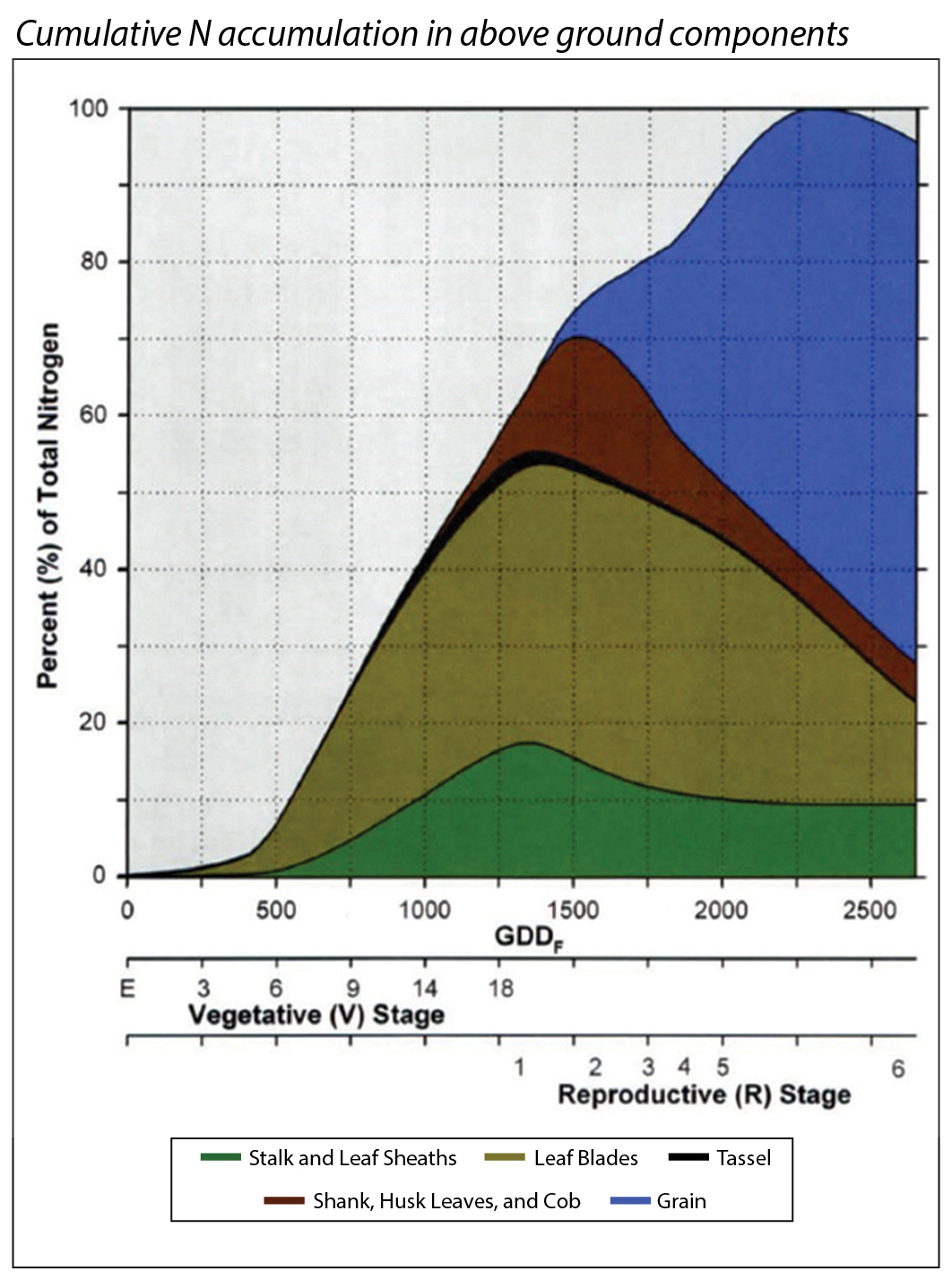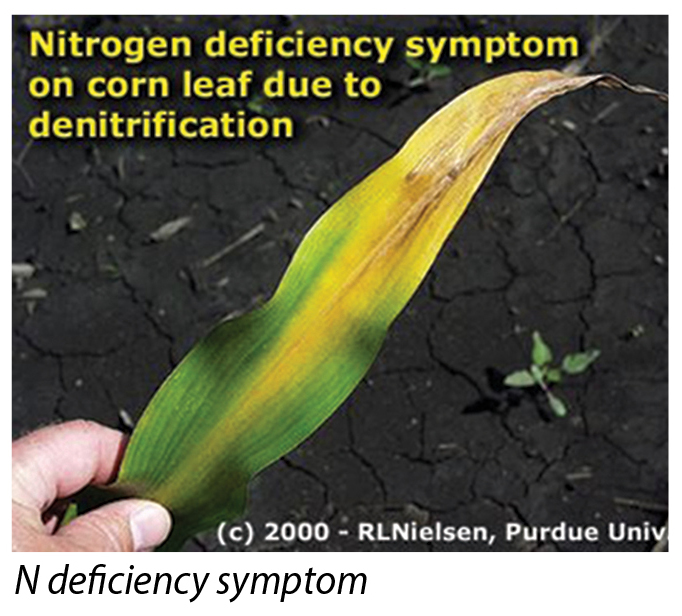Nitrogen (N) is an essential nutrient for successful corn production and there is never a good time to be short of N. The chart below illustrates how much N is accumulated by a corn plant during the growing season.

Approximately 60% of the total amount of N needed by the plant is accumulated from V4 to pollination, making that an especially important time to be mindful of the N available in your fields. After V6 the plant is solely reliant on soil supplied nutrients, and having an N deficiency during this timeframe can have severe impacts on yield. During this rapid uptake period, N is stored in stalk and leaf tissues to be utilized later during grainfill. Post pollination, N uptake decreases and previously stored N is remobilized in effort to fill grain.
Various application methods can be used to ensure N availability to the crop all season long. Pre-plant applications of N are common, as it’s typically easier to find time to do the application. Pre-plant applications have a higher risk of N loss because of the amount of time between application and plant uptake. The application method that poses the least risk of N loss is applying after corn emergence, commonly referred to as sidedressing.
Sidedress N determination
Sidedressing N is essential if little or no N was applied before planting and applications should be made by the V3 growth stage. Sidedressing is often a planned part of N application programs where part of the N is applied before planting and the remainder is applied after emergence. In other cases, sidedressing is used to supplement or replace N lost from pre-plant applications due to weather. This is often the case in wet springs, especially in June, where a significant amount of N can be lost due to leaching or denitrification in warm, saturated soils.
There are various soil and tissue testing methods available to determine if supplemental N is needed after crop emergence. All these methods have their pros and cons and should be studied before using. A popular method of predicting post emergence N applications recently is the use of internet-based N modeling tools. These e-based tools use algorithms that account for current N availability, crop growth stage, weather, and soil parameters. While these aren’t perfect, they do help provide some general guidelines on the effect of weather on N loss and availability.
Another method for determining in-season N needs is the pre-sidedress soil nitrate test (PSNT). This test is often used as part of a scheduled N program or during years where N loss is suspected to be higher due to adverse weather conditions. After collection, these tests indicate current levels of soil nitrate and many often opt to have the soil samples analyzed for ammonium levels as well. Test results are directly used to create sidedress recommendations for the remaining crop N needs.

Another simple method for determining N need is observing the plant’s growth and color. This method is best if N check strips were set up for comparative purposes; however, this method is less likely to be accurate in fine-tuning N needs as there are many factors that can affect plant color and uptake of available N. Regardless of the method utilized, if the crop is expressing N deficiency symptoms at any point from the V4 stage through pollination, a sidedress application of N is usually a wise investment.
Late season N uptake can differ among hybrids, but no hybrid will yield well in N deficient conditions. To ensure maximum yield, regardless of hybrid, manage N in response to your growing conditions and not specific to any one hybrid. Late season N applications or rescue applications can be especially important in years where early season rainfall is above average and N is lost due to leaching or denitrification. These applications can ensure your crop has enough resources to finish the season, not only for sake of yield but also standability.
The best response to sidedress will come from fields with:
- Little or no pre-plant applied N. In these fields, apply N before V3.
- Saturated soils in warm conditions, especially in poorly drained fields.
- Coarse (sandy) soils that received heavy rainfall after planting.
- High pre-plant N losses due to weather (16 inches or more rainfall from April 1st to June 1st).
- Plants showing N deficiency symptoms from the V4 growth stage through pollination.

Fertigation – For those with pivot irrigation systems, in-season N can be efficiently applied through these systems. Proper equipment to avoid backflow into the water source is required when using this method. Fertigation should begin with the first irrigation and be complete by the R1 to R2 growth stages. Application rates of 20-30 lb N/acre per irrigation event are recommended, but higher rates of up to 50 lb N/acre per irrigation event are unlikely to cause crop damage because the fertilizer is diluted in water. It is important that water is applied uniformly, without runoff, to ensure even distribution of N.
Conclusion
There is never a good time for a corn crop to be short of nitrogen. Pre-plant N applications have an increased risk of N loss, leading many corn growers to use sidedressing as part of their nitrogen plan. For others, it’s a way to add supplemental N in fields that have sustained high N loss. In either case, there are factors to consider to ensure the best return on your investment.
